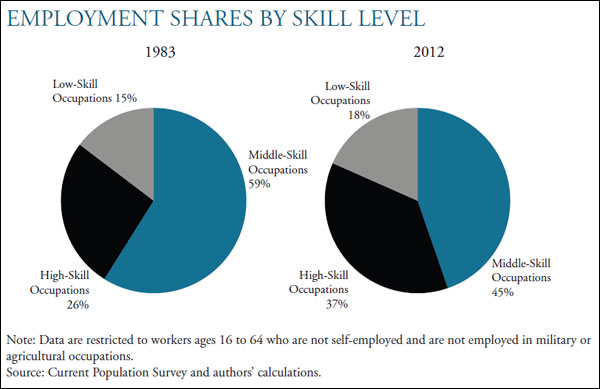The phenomenon of increasing “job polarization” in the U.S. labor market — a sharper division of work into low- and high-skill categories, with fewer middle-skill jobs left — has been well-documented in academic literature. Technology, globalization and the decline of U.S. manufacturing are often thought to be driving this trend. But the precise dynamics are still being investigated.
A 2013 study from economic researchers Didem Tüzemen and Jonathan Willis at the Federal Reserve Bank of Kansas City, “The Vanishing Middle: Job Polarization and Workers’ Response to the Decline in Middle-Skill Jobs,” analyzes 30 years of data from the Census Bureau’s Current Population Survey to build a more accurate national picture of this labor trend. The authors ultimately call into question the “common assumption” that “job polarization has been driven mainly by contraction in a few sectors, such as manufacturing.”
Middle-skill jobs are defined as those where workers “primarily perform routine tasks that are procedural and repetitive.” These are in employment areas such as “sales, office and administrative, production, construction, installation, maintenance and transportation.”
The study is forthcoming in the Economic Review. Its findings include:
- The data suggest that the decline of the manufacturing sector does not fully account for polarization: The trend “has been primarily due to shifts in the skill-composition of jobs within sectors as opposed to the shifts in employment between sectors in the economy. All sectors have experienced declines in the within-sector share of workers in middle-skill jobs.”
- Further, the manufacturing decline has been “partially offset by workers shifting to middle-skill occupations in expanding sectors, such as the education and health services sector.”
- Indeed, the phenomenon of polarization is “structural” and uniform across the economy. Although it has accelerated during recessions, it has continued to take place throughout the past 30 years.
- Different demographic groups have responded in diverse ways: “Women have obtained more education and moved disproportionately into high-skill jobs, while men have shifted in roughly equal numbers to high- and low-skill jobs. Workers age 55 and older have shifted strongly toward high-skill jobs, as workers in high-skill occupations have delayed retirement. For the youngest segment of the labor market, workers ages 16 to 24 have shifted toward low-skill jobs as a growing segment of this population have delayed entry into the labor market while remaining in school.”
- Women in particular have seen dramatic changes: “In 1983, a majority of employed women (55 percent) worked in middle-skill jobs, while the employment shares in high- and low-skill jobs were 26 percent and 19 percent respectively. In 2012, female employment in middle-skill jobs was 18 percentage points lower.” Men saw a 10% shift, with 62% in middle-skill jobs in 1983 compared to 52% in 2012.
- “The main losses in the share of middle-skill employment for women were in office and administrative occupations, likely related to the replacement of many secretarial and clerical jobs with desktop computing. Major employment losses for men were in production occupations, likely related to the decline in manufacturing employment.”
- The returns to higher education are clear: “Workers with a bachelor’s degree or higher have been less affected by job polarization. In 1983, only 26 percent of these workers were in low- and middle-skill occupations. From 1983 to 2012, the share of workers with a bachelor’s degree or higher in middle-skill jobs declined modestly by 5 percentage points.”
The study also features this chart illustrating these shifts over time:

Tags: economy, financial crisis, women and work

Expert Commentary